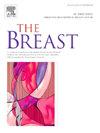Tall Cell Carcinoma with Reversed Polarity of the breast: Clinicopathological insights, molecular profile, and future therapeutic directions
IF 5.7
2区 医学
Q1 OBSTETRICS & GYNECOLOGY
引用次数: 0
Abstract
Tall Cell Carcinoma with Reversed Polarity (TCCRP) is a rare and distinct subtype of invasive breast carcinoma, first described in 2003. It is histologically characterized by tall columnar epithelial cells with reversed nuclear polarity and shares morphological features with papillary thyroid carcinoma (PTC). However, its unique molecular signature, including IDH2 and PIK3CA mutations, differentiates it from other breast cancer subtypes. A retrospective systematic study of 91 published cases of TCCRP was conducted, including two cases from our institution. Clinical, pathological, molecular, and treatment-related data were collected and analyzed. Descriptive statistics and Kaplan-Meier survival analysis were employed to evaluate disease-free survival (DFS) and overall survival (OS). Subgroup analyses explored associations between clinical features, molecular markers, and outcomes. The median age at diagnosis was 64 years, with a predominance of small tumors (mean size: 10.4 mm, T1 stage). Histologically, hallmark features included reversed nuclear polarity (100 %), nuclear grooves, and intranuclear pseudoinclusions. Immunohistochemical analysis confirmed a triple-negative profile (ER-/PR-/HER2-) in most cases, with consistent breast-specific marker expression (GATA3, CK7). Molecular testing revealed frequent IDH2 R172 (84.6 %) and PIK3CA (72.5 %) mutations. Surgical management, predominantly breast-conserving surgery (BCS), was the primary treatment, with adjuvant therapies rarely utilized. At a median follow-up of 35.8 months, recurrence occurred in only 2.2 % of cases, and the overall survival rate was 100 %. TCCRP is a rare, low-grade breast cancer subtype with a favorable prognosis and low recurrence risk based on currently available data, but longer follow-up studies are needed to confirm this observation. Its distinct histological and molecular features enable accurate diagnosis and differentiation from other breast cancers and metastatic thyroid carcinoma. Given its indolent nature, conservative treatment strategies, including BCS, are effective, and adjuvant therapies can be minimized. Future research should explore targeted therapies for IDH2 and PIK3CA mutations to expand treatment options for this unique subtype.
乳腺极性反转的高细胞癌:临床病理见解、分子特征和未来治疗方向
逆转极性高细胞癌(TCCRP)是一种罕见而独特的浸润性乳腺癌亚型,于2003年首次报道。其组织学特征为细胞核极性逆转的高柱状上皮细胞,与甲状腺乳头状癌(PTC)具有相同的形态学特征。然而,其独特的分子特征,包括IDH2和PIK3CA突变,将其与其他乳腺癌亚型区分开来。对91例已发表病例进行回顾性系统研究,其中2例来自我院。收集并分析临床、病理、分子及治疗相关资料。采用描述性统计和Kaplan-Meier生存分析评价无病生存期(DFS)和总生存期(OS)。亚组分析探讨了临床特征、分子标志物和预后之间的关系。诊断时的中位年龄为64岁,以小肿瘤为主(平均大小:10.4 mm, T1期)。组织学特征包括核极性反转(100%)、核槽和核内假内含物。免疫组织化学分析证实大多数病例为三阴性(ER-/PR-/HER2-),具有一致的乳腺特异性标志物表达(GATA3, CK7)。分子检测显示IDH2 R172(84.6%)和PIK3CA(72.5%)频繁突变。手术治疗,主要是保乳手术(BCS),是主要的治疗方法,辅助治疗很少使用。在35.8个月的中位随访中,只有2.2%的病例复发,总生存率为100%。根据现有数据,TCCRP是一种罕见的低级别乳腺癌亚型,预后良好,复发风险低,但需要更长的随访研究来证实这一观察结果。其独特的组织学和分子特征使其能够准确诊断和区分其他乳腺癌和转移性甲状腺癌。鉴于其惰性性质,保守治疗策略,包括BCS,是有效的,辅助治疗可以最小化。未来的研究应该探索针对IDH2和PIK3CA突变的靶向治疗,以扩大这种独特亚型的治疗选择。
本文章由计算机程序翻译,如有差异,请以英文原文为准。
求助全文
约1分钟内获得全文
求助全文
来源期刊

Breast
医学-妇产科学
CiteScore
8.70
自引率
2.60%
发文量
165
审稿时长
59 days
期刊介绍:
The Breast is an international, multidisciplinary journal for researchers and clinicians, which focuses on translational and clinical research for the advancement of breast cancer prevention, diagnosis and treatment of all stages.
 求助内容:
求助内容: 应助结果提醒方式:
应助结果提醒方式:


